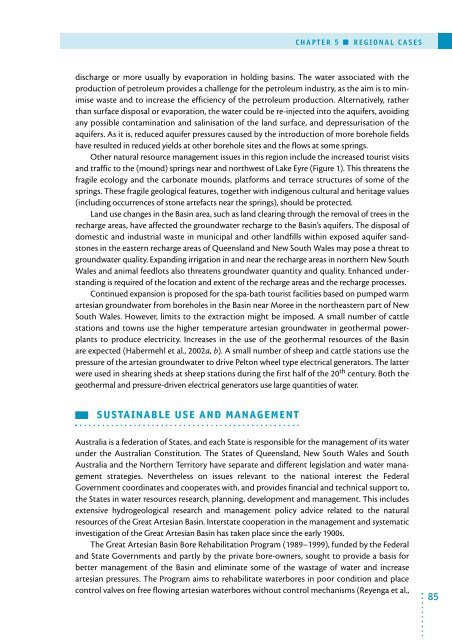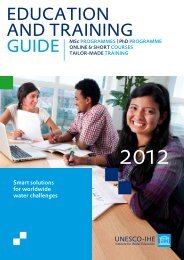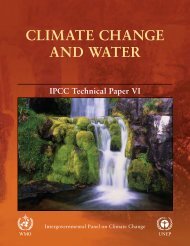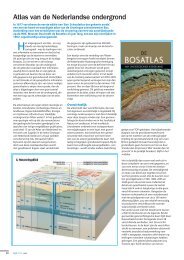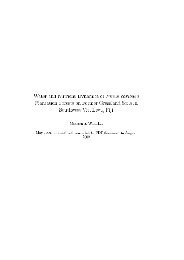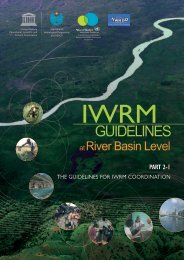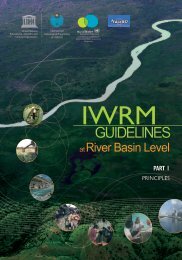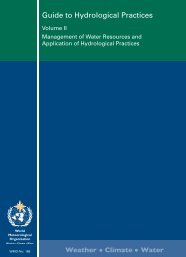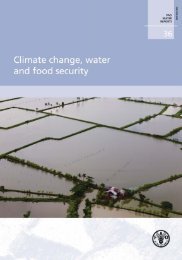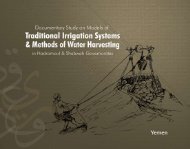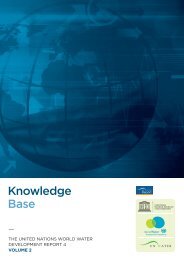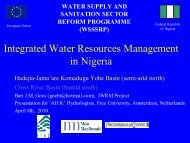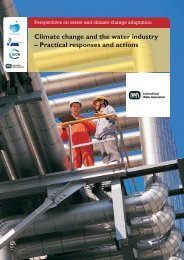Non-renewable groundwater resources: a ... - unesdoc - Unesco
Non-renewable groundwater resources: a ... - unesdoc - Unesco
Non-renewable groundwater resources: a ... - unesdoc - Unesco
- No tags were found...
You also want an ePaper? Increase the reach of your titles
YUMPU automatically turns print PDFs into web optimized ePapers that Google loves.
CHAPTER 5 ■ REGIONAL CASESdischarge or more usually by evaporation in holding basins. The water associated with theproduction of petroleum provides a challenge for the petroleum industry, as the aim is to minimisewaste and to increase the efficiency of the petroleum production. Alternatively, ratherthan surface disposal or evaporation, the water could be re-injected into the aquifers, avoidingany possible contamination and salinisation of the land surface, and depressurisation of theaquifers. As it is, reduced aquifer pressures caused by the introduction of more borehole fieldshave resulted in reduced yields at other borehole sites and the flows at some springs.Other natural resource management issues in this region include the increased tourist visitsand traffic to the (mound) springs near and northwest of Lake Eyre (Figure 1). This threatens thefragile ecology and the carbonate mounds, platforms and terrace structures of some of thesprings. These fragile geological features, together with indigenous cultural and heritage values(including occurrences of stone artefacts near the springs), should be protected.Land use changes in the Basin area, such as land clearing through the removal of trees in therecharge areas, have affected the <strong>groundwater</strong> recharge to the Basin’s aquifers. The disposal ofdomestic and industrial waste in municipal and other landfills within exposed aquifer sandstonesin the eastern recharge areas of Queensland and New South Wales may pose a threat to<strong>groundwater</strong> quality. Expanding irrigation in and near the recharge areas in northern New SouthWales and animal feedlots also threatens <strong>groundwater</strong> quantity and quality. Enhanced understandingis required of the location and extent of the recharge areas and the recharge processes.Continued expansion is proposed for the spa-bath tourist facilities based on pumped warmartesian <strong>groundwater</strong> from boreholes in the Basin near Moree in the northeastern part of NewSouth Wales. However, limits to the extraction might be imposed. A small number of cattlestations and towns use the higher temperature artesian <strong>groundwater</strong> in geothermal powerplantsto produce electricity. Increases in the use of the geothermal <strong>resources</strong> of the Basinare expected (Habermehl et al., 2002a, b). A small number of sheep and cattle stations use thepressure of the artesian <strong>groundwater</strong> to drive Pelton wheel type electrical generators. The latterwere used in shearing sheds at sheep stations during the first half of the 20 th century. Both thegeothermal and pressure-driven electrical generators use large quantities of water.SUSTAINABLE USE AND MANAGEMENTAustralia is a federation of States, and each State is responsible for the management of its waterunder the Australian Constitution. The States of Queensland, New South Wales and SouthAustralia and the Northern Territory have separate and different legislation and water managementstrategies. Nevertheless on issues relevant to the national interest the FederalGovernment coordinates and cooperates with, and provides financial and technical support to,the States in water <strong>resources</strong> research, planning, development and management. This includesextensive hydrogeological research and management policy advice related to the natural<strong>resources</strong> of the Great Artesian Basin. Interstate cooperation in the management and systematicinvestigation of the Great Artesian Basin has taken place since the early 1900s.The Great Artesian Basin Bore Rehabilitation Program (1989–1999), funded by the Federaland State Governments and partly by the private bore-owners, sought to provide a basis forbetter management of the Basin and eliminate some of the wastage of water and increaseartesian pressures. The Program aims to rehabilitate waterbores in poor condition and placecontrol valves on free flowing artesian waterbores without control mechanisms (Reyenga et al.,85


